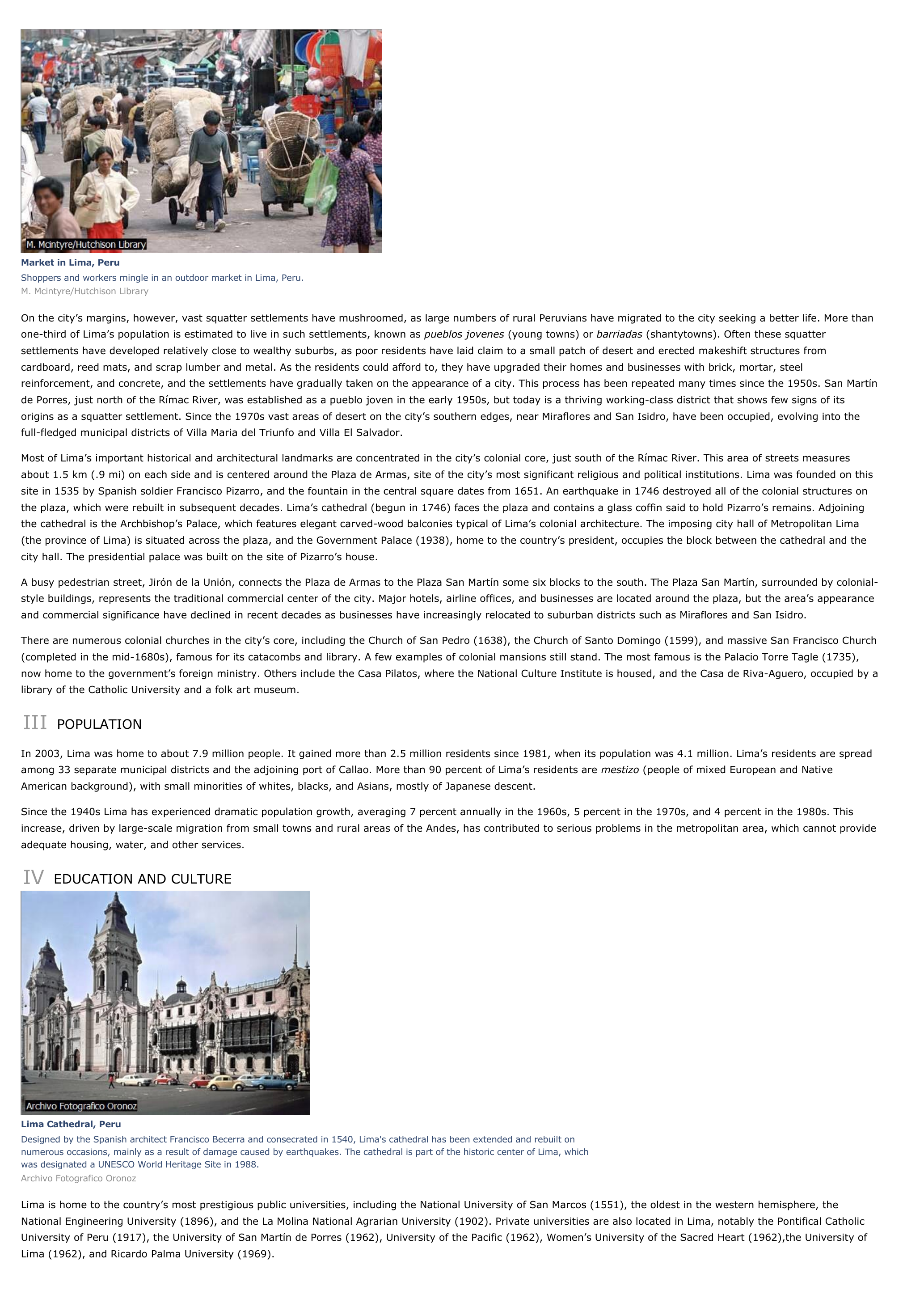Lima (Peru) - geography.
Publié le 27/05/2013

Extrait du document
«
Market in Lima, PeruShoppers and workers mingle in an outdoor market in Lima, Peru.M.
Mcintyre/Hutchison Library
On the city’s margins, however, vast squatter settlements have mushroomed, as large numbers of rural Peruvians have migrated to the city seeking a better life.
More thanone-third of Lima’s population is estimated to live in such settlements, known as pueblos jovenes (young towns) or barriadas (shantytowns).
Often these squatter settlements have developed relatively close to wealthy suburbs, as poor residents have laid claim to a small patch of desert and erected makeshift structures fromcardboard, reed mats, and scrap lumber and metal.
As the residents could afford to, they have upgraded their homes and businesses with brick, mortar, steelreinforcement, and concrete, and the settlements have gradually taken on the appearance of a city.
This process has been repeated many times since the 1950s.
San Martínde Porres, just north of the Rímac River, was established as a pueblo joven in the early 1950s, but today is a thriving working-class district that shows few signs of itsorigins as a squatter settlement.
Since the 1970s vast areas of desert on the city’s southern edges, near Miraflores and San Isidro, have been occupied, evolving into thefull-fledged municipal districts of Villa Maria del Triunfo and Villa El Salvador.
Most of Lima’s important historical and architectural landmarks are concentrated in the city’s colonial core, just south of the Rímac River.
This area of streets measuresabout 1.5 km (.9 mi) on each side and is centered around the Plaza de Armas, site of the city’s most significant religious and political institutions.
Lima was founded on thissite in 1535 by Spanish soldier Francisco Pizarro, and the fountain in the central square dates from 1651.
An earthquake in 1746 destroyed all of the colonial structures onthe plaza, which were rebuilt in subsequent decades.
Lima’s cathedral (begun in 1746) faces the plaza and contains a glass coffin said to hold Pizarro’s remains.
Adjoiningthe cathedral is the Archbishop’s Palace, which features elegant carved-wood balconies typical of Lima’s colonial architecture.
The imposing city hall of Metropolitan Lima(the province of Lima) is situated across the plaza, and the Government Palace (1938), home to the country’s president, occupies the block between the cathedral and thecity hall.
The presidential palace was built on the site of Pizarro’s house.
A busy pedestrian street, Jirón de la Unión, connects the Plaza de Armas to the Plaza San Martín some six blocks to the south.
The Plaza San Martín, surrounded by colonial-style buildings, represents the traditional commercial center of the city.
Major hotels, airline offices, and businesses are located around the plaza, but the area’s appearanceand commercial significance have declined in recent decades as businesses have increasingly relocated to suburban districts such as Miraflores and San Isidro.
There are numerous colonial churches in the city’s core, including the Church of San Pedro (1638), the Church of Santo Domingo (1599), and massive San Francisco Church(completed in the mid-1680s), famous for its catacombs and library.
A few examples of colonial mansions still stand.
The most famous is the Palacio Torre Tagle (1735),now home to the government’s foreign ministry.
Others include the Casa Pilatos, where the National Culture Institute is housed, and the Casa de Riva-Aguero, occupied by alibrary of the Catholic University and a folk art museum.
III POPULATION
In 2003, Lima was home to about 7.9 million people.
It gained more than 2.5 million residents since 1981, when its population was 4.1 million.
Lima’s residents are spreadamong 33 separate municipal districts and the adjoining port of Callao.
More than 90 percent of Lima’s residents are mestizo (people of mixed European and Native American background), with small minorities of whites, blacks, and Asians, mostly of Japanese descent.
Since the 1940s Lima has experienced dramatic population growth, averaging 7 percent annually in the 1960s, 5 percent in the 1970s, and 4 percent in the 1980s.
Thisincrease, driven by large-scale migration from small towns and rural areas of the Andes, has contributed to serious problems in the metropolitan area, which cannot provideadequate housing, water, and other services.
IV EDUCATION AND CULTURE
Lima Cathedral, PeruDesigned by the Spanish architect Francisco Becerra and consecrated in 1540, Lima's cathedral has been extended and rebuilt onnumerous occasions, mainly as a result of damage caused by earthquakes.
The cathedral is part of the historic center of Lima, whichwas designated a UNESCO World Heritage Site in 1988.Archivo Fotografico Oronoz
Lima is home to the country’s most prestigious public universities, including the National University of San Marcos (1551), the oldest in the western hemisphere, theNational Engineering University (1896), and the La Molina National Agrarian University (1902).
Private universities are also located in Lima, notably the Pontifical CatholicUniversity of Peru (1917), the University of San Martín de Porres (1962), University of the Pacific (1962), Women’s University of the Sacred Heart (1962),the University ofLima (1962), and Ricardo Palma University (1969)..
»
↓↓↓ APERÇU DU DOCUMENT ↓↓↓
Liens utiles
- Lima (Peru) - geography.
- Lima - geographie.
- Jorge de Lima - idiomas.
- Rose de Lima, sainte - religieux.
- Peru - geographie.

































